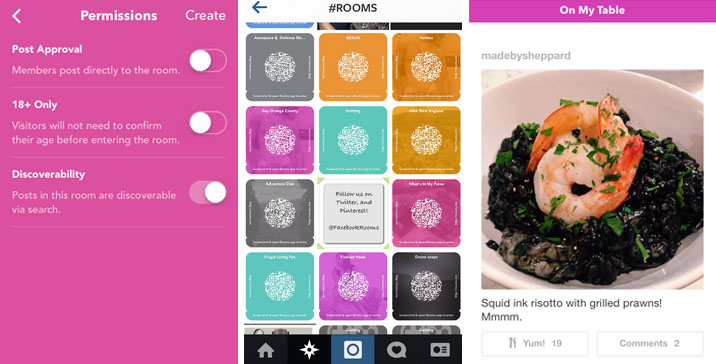If you haven’t heard about it yet, don’t feel bad; Facebook’s new pseudo-anonymous app Rooms, launched on October 24, is meant to be secretive. This app, built by Josh Miller and his team from Branch, was bought by Facebook in January. As of now, Rooms is only available on iOS devices, but an Android app is planned to launch early in 2015.
Facebook is taking a completely different approach with this new app. Rooms connects users based on similar passions and hobbies rather than via mutual friends or geographical connections. To use the app, simply download it and join a room by scanning a QR code of your choice. After joining a room, users can choose different “nicknames” without having to be connected back to their Facebook accounts. The company is pushing its approach as a way for users to “Be whoever you want to be.”
Launched out of the blue without much detail, many have been confused about how to use the app effectively. We’re giving you the low-down on Rooms, how to use it and how brands could take advantage of it.
What is a room?
A room is a space where members can share photos, videos and text about any particular topic. Anyone can create a room. Room creators can customize it in various ways, from cover photos to color schemes. Room creators can also customize the “like” buttons with text and emojis. For example, the “like” button in the “On My Table” room is represented with a fork and knife emoji and the word “Yum!” Admins also have the option to pin posts to the top of the feed and edit the room’s discoverability settings, age restriction as well as post-approving options before creating it. Once a room has been created and is active, both admins and Rooms’ moderators have the ability to delete inappropriate posts and ban users.

How do you join a room?
This is where the app gets complicated. There is no way for a user to search for topics in the app itself. To join a room, you must scan or take a screenshot of a QR code, then go to the homepage of the app and tap “use invite.” The app will ask permission to access your photos and you must select the QR code image from your phone’s photos that you want to upload. Some other ways to find rooms with people that have similar passions and hobbies include:
- Search the hashtag #Rooms on Instagram, Twitter or Facebook and scroll through the many QR codes that users have posted.
- Browse the “Recommended Rooms” room created by the Rooms team. Once the app is downloaded, users are taken through a tutorial and given the option to join this room where the team posts QR codes and descriptions of rooms that are public and have interesting content.
How can brands take advantage of Rooms?
Rooms is still fairly new, which is why brands have yet to find effective ways to promote themselves on the app. One of the main goals for a brand using Rooms should be to drive organic, honest conversation. Brands should choose more general topics rather than promote a specific product or service. The main challenge that organizations will face is the inability to search for rooms or users within the app, which is why they will have to use the same strategy they use to share their Snapchat usernames — promoting their rooms through other social and marketing channels. If the conversation is engaging and users are passionate about the topic, your brand’s room has the potential to grow on its own via word of mouth.
 Personal brands have the potential to grow via Rooms as well. Kaila Mullady, a beatbox phenom, started a room called “The Beetbox” where “all beat boxers, loopers and vocal stylists” can find inspiration and share their talent. Mullady is using Rooms to promote herself, provide a
Personal brands have the potential to grow via Rooms as well. Kaila Mullady, a beatbox phenom, started a room called “The Beetbox” where “all beat boxers, loopers and vocal stylists” can find inspiration and share their talent. Mullady is using Rooms to promote herself, provide a
space for other artists to get discovered, and encourage relevant brands in the industry to start conversations.
A problem brands will face, however, involves the anonymity factor of the app. Criticism and controversy should be expected from users because they have the option to remain anonymous. Brands should think about their room topic carefully and anticipate negative comments ahead of time.
Facebook has been trying to compete with Twitter for a while, and with Rooms they just might be able to accomplish that goal. Instead of categorizing conversation by hashtags like Twitter, this new app allows conversation on topics without bothering those that do not care. It is a great way for a brand to begin conversation about an issue it is passionate about, and invite people that are interested via other media platforms. Here are some tactics brands could use to promote and utilize their rooms:
- Plan chats and Q&A sessions with relevant speakers or brand ambassadors. Once you’re in a room, you can post text, photos or videos. Rooms can provide another platform for an organized web chat atmosphere similar to a Reddit AMA, with the added bonus of photos and videos.
- Become the go-to expert on a related topic. It would also be a good idea to join other rooms with relevant topics and lead conversation. Brands should monitor related #rooms hashtags on other social media platforms to make sure they’re not the topic of a conversation that they don’t even know about. If they are, they shouldn’t be afraid to get in on the conversation themselves.
- Announce exclusive giveaways or launches that are targeted to those participating in their rooms or rooms with a relevant audience.
- Drive an event with a room rather than a hashtag. Scanning a QR code at an event to immediately join discussion and share comments, pictures or videos would be a great way to get attendees more involved. This is another way Rooms may compete with Twitter.
- Distribute the QR code with the help of street teams. While sharing a QR code through email, text or social media is more instantaneous, brands could also hire street teams to print out QR codes and distribute them in targeted areas or events.
What is the future of Rooms?
Rooms is barely a few weeks old, but it’s already getting a lot of attention. Many are referring to it as a throwback to 1990s chat rooms or comparing it to other anonymous apps such as Reddit, Secret, Whisper, or Yik Yak. However, Rooms tends to be more community-based than self-based. Miller believes that Rooms is capable of much more. In a TechCrunch article Miller says, “I think the coolest rooms will be things we haven’t thought of yet. The Twitter guys didn’t know what Twitter would be good for. The Snapchat guys didn’t know what Snapchat would be good for.”
Rooms will have to make several updates in order to grow. The inability to easily invite people to join rooms, especially for brands, may hinder the growth of the app. The Rooms team will have to make it easier for users to search and join topics that interest them. Screenshotting and uploading a QR code can get pretty tedious in a world where everyone wants quick results. This potential problem stems from the app’s central focus on anonymity, and only time will tell whether it’s a successful strategy. Brands especially will have a difficult time proving their identity from room to room because of this feature. The Rooms team, or perhaps community, will have to come up with a verification process similar to Reddit’s AMA verification or Twitter’s blue checkmark.
Will Rooms be successful enough among users for brands to consider using it? Tweet us @bigfishmarket and let us know what you think!
– Kosha Shah


